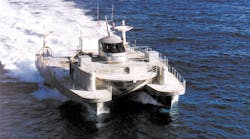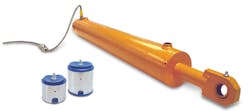Lockheed Martin’s SLICE technology is a patented ship design that enables Small Waterplane Area Twin Hull (SWATH) ships to operate at high speeds without sacrificing efficiency. The Sea SLICE prototype shown here is only 105-ft long and 52-ft wide, but is as stable in rough seas as a 350-ft conventional monohull ship.
The key to the SWATH innovation is reduction of wave-making drag, which is accomplished by introducing four teardrop-shaped submerged hulls. Each hull houses a rudder control system, which relies on four smart cylinders from Control Products Inc. (CPI), East Hanover, N. J., to provide controlled motion in two axes. One pair of cylinders controls deflection, and the other controls rotation. The cylinders actuate rudders, which control both the direction and the ride height of the vessel.
Precise, reliable control of the rudders is a big advantage of Sea SLICE technology. Automated rudder control is used to optimize the performance of the ship, constantly modulating position based on feedback from several parameters, including the ship’s attitude and speed. Closed-loop feedback is also used for defining preset fin positions.
Early generation rudder systems used external position sensors coupled to mechanical linkages. These added complexity to the design and created problems with adjustment. The CPI smart cylinder eliminated these problems because its linear displacement transducer resides completely inside it. In fact, these cylinders are not discernable from standard hydraulic cylinders, except for the M12-style electrical connector on the side.
Mac Stuhler, vice president of CPI, says the smart cylinders use SL Series linear displacement transducers to provide electronic feedback of piston position. “This new, non-contacting, absolute sensor technology was developed to meet the needs of mobile equipment applications.
“Unlike conventional in-cylinder displacement transducers, no center drilling of the rod is required. This provides a huge reduction in installation cost because so little modification to the cylinder is needed. This means virtually any single-rod cylinder design can be converted into a CPI smart cylinder.”
For this application, a shielded cable — which carries supply and feedback signals — plugs into the cylinder via the M 12-style connector. Stuhler continues, “The transducer’s in-line signal conditioner accepts any voltage from 12- to 24- Vdc and provides the controller with a highly repeatable 0.5- to 4.5- Vdc analog output. Because it’s vehicle hardened to ASAE EP455, the transducer stands up to the rugged conditions of this and most other applications.”
Officials at Lockheed Martin see a strong market for a high-speed, fully operational vessel that offers quick response, unlimited operations, while remaining cost-effective. Combining increased speed capability with extraordinary stability in high seas, Sea SLICE technology represents an innovation that opens a new set of options to commercial and military customers. Innovations in electronics for fluid technology, such as CPI smart cylinders, help ensure the advancement of electrohydraulics not only for Lockheed Martin, but a wide range of mobile and industrial applications as well.
Click here to view a video of Lockheed Martin's Sea SLICE in action.
For more information, contact Mac Stuhler at [email protected] or visit www.cpi-nj.com.



